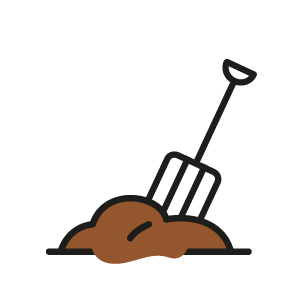Soils
- 8 cm of soil contains 13 quadrillion living organisms. [1]
- The weight of bacteria in 1 hectare of soil is equivalent to the weight of 2 cows. [1]
- There are more organisms in 1 gram of healthy soil than there are people on Earth.[1]
- Soil contains the most diverse terrestrial communities on the planet.[1]
- One gram of healthy soil can contain up to 1 Billion microorganisms and several meters of fungal hyphae. [2]
- The world grows 95% of its food in the uppermost layer of soil, making topsoil one of the most important components of our food system. [3]
- For each 1-percent increase in soil organic matter, the available water holding capacity in the soil increased by 3.7 percent. [4]
- The world’s largest known organism is a fungus (Armillaria ostoyae) that occupies 965 hectares of soil in Oregon’s Blue Mountains. That would encompass 1,665 football fields or nearly 10 square kilometers of turf.
- There are more than 1,000 different earthworm species that aerate the world’s soils, but they can all be placed into one of the following three groups: Litter dwellers live in crop or forest litter, Topsoil dwellers live in the upper 2 to 3 inches of the soil, Subsoil dwellers live in permanent vertical burrows that can be 5 or 6 feet deep.
- Bio-slurry and compost are excellent sources of valuable nutrients that can help to counter effects of soil acidification
- Bio-digesters take two to three days to kill 90% of pathogens in animal manure, including E. coli and Salmonella.
Sources:
[1] The poster of Food and Agriculture Organization of the United Nations and Global Soil Partnership
[2] “The secret life of soil” by Prof. Peg Herring, director of communications for the College of Agricultural Sciences and editor of Oregon’s Agricultural Progress magazine at Oregon State University. https://extension.oregonstate.edu/news/secret-life-soil
[3] https://www.theguardian.com/us-news/2019/may/30/topsoil-farming-agriculture-food-toxic-america
[4] Hudson, B.D. (1994) Soil organic matter and available water capacity. Journal of Soil and Water Conservation, 49, 189-194.
Fertilisers
- Fertilisers account for 50% of global food production consumed by both animals and humans. When applied at the optimum rate, 1kg of nitrogen will result in an extra 22kg of grain for most cereal crops.
- The use of fertiliser can safeguard natural habitats and forests from being converted into farmland.- Fertilisers feed plants for better, healthier, stronger yields thatwill feed the world for centuries to come.
- Over the next 50 years farmers will need to produce more food than has been grown over the past 10,000 years, fertilisers will play a large role in ensuring this.
- In 1960, one hectare of land fed two people. However, by 2025, one hectare of land will need to feed five people.
Source: https://www.agriland.ie
